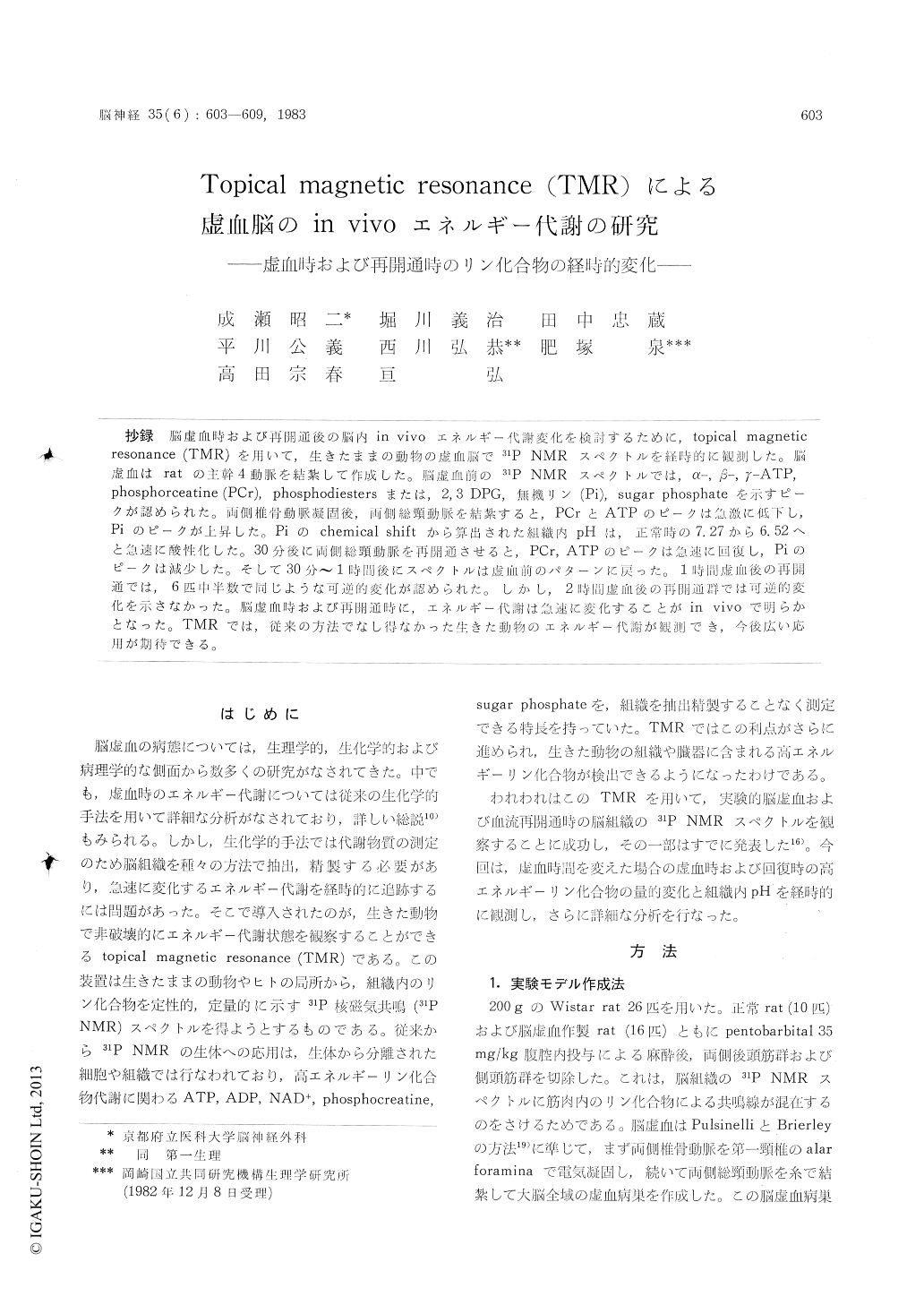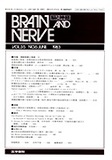Japanese
English
- 有料閲覧
- Abstract 文献概要
- 1ページ目 Look Inside
抄録 脳虚血時および再開通後の脳内in vivoエネルギー代謝変化を検討するために,topical magneticresonance (TMR)を用いて,生きたままの動物の虚血脳で31P NMRスペクトルを経時的に観測した。脳虚血はratの主幹4動脈を結紮して作成した。脳虚血前の31P NMRスペクトルでは,α—,β—,γ—ATP,phosphorceatine (PCr),phosphodiestersまたは,2,3DPG,無機リン(Pi),sugar phosphateを示すピークが認められた。両側椎骨動脈凝固後,両側総頸動脈を結紮すると,PCrとATPのピークは急激に低下し,Piのピークが上昇した。Piのchemical shiftから算出された,組織内pHは,正常時の7.27から6.52へと急速に酸性化した。30分後に両側総頸動脈を再開通させると,PCr,ATPのピークは急速に回復し,Piのピークは減少した。そして30分〜1時間後にスペクトルは虚血前のパターンに戻った。1時間虚血後の再開通では,6匹中半数で同じような可逆的変化が認められた。しかし,2時周虚血後の再開通群では可逆的変化を示さなかった。脳虚血時および再開通時に,エネルギー代謝は急速に変化することがin vivoで明らかとなった。TMRでは,従来の方法でなし得なかった生きた動物のエネルギー代謝が観測でき,今後広い応用が期待できる。
Sequential metabolic changes in rat brain were monitored by in vivo measurement of 31P NMR spectra using a topical magnetic resonance (TMR) spectrometer, during the course of experimentally induced cerebral infarction and during its recovery by restoration of circulation.
There were several peaks in the spectrum of the normal rat brain ; the β-ATP, α-ATP and α-ADP with contribution from NAD+/NADH, γ-ATP and ,β-ADP, phosphocreatine, phosphodie-sters or 2, 3 DPG, inorganic phosphate and sugar phosphate with contribution from AMP.
The experimental cerebral ischemia was render-ed to 16 Wistar rats by the method of Pulsinelli and Brierley. The coagulation of the bilateralvertebral arteries did not show any changes in NMR spectra, but the subsequent ligation of bilateral common carotid arteries produced a decrease in the peak of ATP and phosphocreatine and a concomitant increase in the peak of inorganic phosphate. The tissue pH, which was calculated from the chemical shift of inorganic phosphate, declined. These changes occurred rapidly within a few minutes, being followed by a gradual increase in their degree after the ischemia.
Reinstatement of blood circulation to the cereb-rum were made by untying the ligature of common carotid arteries in 6 rats at 30 minutes after, in 6 rats at 60 minutes after and in 4 rats at 120 minutes after the ischemia. The reinstate-ment of the circulation resulted in a immediaterestoration of the peaks of ATP and phosphocre-atine and in a reduction of the peak of inorganic phosphate within a few minutes in all rats of 30 minutes ischemia and a half of rats of 60 minutes ischemia. Their spectra recovered to preinfarction patterns by 30 to 60 minutes after the recircula-tion. However, no recovery of spectra were shown in a remained half of rats of 60 minutes ischemia and in all of 120 minutes ischemia.
These experiments demonstrated that high energy phosphorus compounds decrease very rapidly after the ischemia, and that these changes were reversible if the restoration of the circula-tion was made at least 30 to 60 minutes periods of ischemia.

Copyright © 1983, Igaku-Shoin Ltd. All rights reserved.


